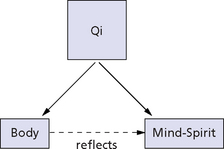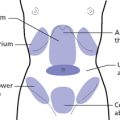 OBSERVATION OF THE MIND, SPIRIT AND EMOTIONS
OBSERVATION OF THE MIND, SPIRIT AND EMOTIONS
INTRODUCTION
The Mind and Spirit are formed from the Prenatal Essences of the parents and are nourished by the Postnatal Essence of food and water taken in by the body. For example, Chapter 32 of the “Spiritual Axis” says: “The Mind and Spirit result from the transformation of the Essence of food and water.”1
Chapter 9 of the “Simple Questions” says:
Heaven provides human beings with the five Qi [air] and Earth provides human beings with the five flavours [food]. The air is absorbed through the nose, and is stored in the Lungs and Heart. It ascends to make the complexion bright and lustrous and the voice sonorous. The food is taken through the mouth, and is stored in the Stomach and Intestines. After the food is digested and absorbed, the food Essence is delivered to the five Yin organs and therefore nourishes the Qi of the five Yin organs. When the Qi of the five Yin organs is in a state of harmony, the body can transform properly, body fluids are produced normally and the Mind and Spirit are formed.2
The Essence, Qi and Blood are the material foundation of the Mind and Spirit and, conversely, the Mind and Spirit are the external manifestation of Essence, Qi and Blood. Chapter 18 of the “Spiritual Axis” says: “The Stomach is in the Middle Burner, it opens into the Upper Burner, it receives Qi, excretes the dregs, evaporates the fluids, transforming them into a refined essence. This pours upwards towards the Lungs and is transformed into Blood … Blood is the foundation of the Mind and Spirit.”3 All the above quotations highlight the relation between the Essence, Qi, Blood and the Mind/Spirit.
The “Great Dictionary of Chinese Medicine” says: “Human life originates from the Essence. It is maintained by Qi and manifested through the Mind and Spirit. Qi, Blood and Essence are the material foundation of the Mind and Spirit. Therefore, when Qi, Blood and Essence are sufficient, the Mind and Spirit are healthy. If there is deficiency of Qi, Blood and Essence, the Mind and Spirit suffer.”4
As we know, Qi is a subtle life force which is manifested simultaneously in the body in all its physiological activities and in the Mind and Spirit in its emotional and thinking activities (Fig. 2.1). For example, the pathological condition of Liver-Qi stagnation manifests with physical signs such as abdominal distension and simultaneously with emotional signs such as depression or mood swings.
THE THREE ASPECTS OF THE SPIRIT
When observing and assessing the Spirit of a person, we should examine three separate aspects:
The vitality of the Spirit
Observation
The vitality of the Spirit is its manifestation in the general vitality of a person: the “energy” radiated by people which reflects their Spirit. Observation of the vitality of the Spirit is an integral part of the observation of the Spirit. If the vitality of the Spirit is vibrant, then a person will have a clear mind, high energy, a strong voice, regular breathing, clear thinking and quick reflexes. If the vitality of the Spirit is dull, a person will have low energy, a weak voice, dull expression, lethargy, apathy and, in severe cases, mental confusion.
Clinical significance
The chapter “Key to the Four Diagnostic Methods” of “The Golden Mirror of Medicine” says: “In the beginning of a disease, the state of the Spirit is important. The reason is that if the Spirit is strong at the beginning of a disease, it means that pathogenic factors cannot defeat the Upright Qi, as it is still strong. If the Spirit is dull, it shows that the Upright Qi cannot resist pathogenic factors as it is deficient.”5
The lustre of the Spirit
Observation
No matter what the colour is, there should be lustre (shen). In lustre, one can differentiate light and body. “Light” refers to a bright appearance on the surface, while “body” refers to the moisture below the surface of the skin. Light has no form and reflects Yang and Qi. Body has a form and reflects Yin and Blood. If there is no abnormality of Qi and Blood, and Yin and Yang are in harmony, the lustre will have normal light and body.6
THE THREE CONDITIONS OF THE SPIRIT
When examining the state of the Mind and Spirit, there are three basic conditions:
Weak Spirit
Observation
Chapter 17 of the “Simple Questions” describes the manifestation of a weak Spirit by observation of the head and eyes: “The five Yin organs house the Spirit; they are essential for the body to be strong. The head is the residence of the Spirit: if the head droops and the eyes are deep-socketed and dull, it means that the Spirit is exhausted.”7
The Spirit is housed in the Heart. It is not substantial or visible but it manifests in the eyes. If the eyes look dull, it means that the Spirit is exhausted: it indicates a poor prognosis. If the eyes are bright and clear, it denotes that the Spirit is vital and the body is free of disease … If there is delirium and incoherent speech, it indicates that the Spirit is gone.8
False Spirit
Observation
The False Spirit indicates the momentary improvement in energy of a patient during a severe, chronic disease: it is not a good sign but an omen of death. The manifestations of the False Spirit are as follows: in a patient suffering from a severe, chronic disease and previously suffering from a weak Spirit, suddenly the energy seems better, the eyes become bright, the patient suddenly talks a lot and wants to meet family members, the voice, previously feeble, suddenly becomes clear and loud, the complexion, previously dark, suddenly becomes bright red and the appetite suddenly comes back. These manifestations are due to the extreme exhaustion of the Essence and Qi. In such a circumstance, Yin fails to restrain Yang so that Yang floats outwards and upwards, causing the false appearance of an improvement. In ancient times, people compared it to the last flicker of a fading oil lamp or the last radiance of the setting sun. It is a dangerous sign indicating the separation of Yin and Yang.9
THE SPIRIT AND CONSTITUTION
When observing the mental and emotional state of a person, it is important first of all to assess the relative strength of the Spirit compared with that of the constitution, both the prenatal and postnatal as described above. The Spirit and the constitution are both reflections of the Essence and Qi of the body, the former in the mental—spiritual sphere and the latter in the physical sphere. Because of the close connection between the Spirit and the constitution of a person, generally a strong pre- and postnatal constitution is accompanied by a strong Spirit; conversely, a weak pre- and postnatal constitution is generally accompanied by a weak Spirit. However, there may be cases when there is a divergence between these two aspects, that is, the person has a strong pre- and postnatal constitution but a weak Spirit, or vice versa.
Strong Spirit and strong constitution
Clinical significance
The above physical and mental characteristics indicate both a good constitution and a strong Spirit; the internal organs of such a person are strong and function normally, Qi and Blood are abundant and the Mind and Spirit are healthy. The body will not be easily invaded by pathogenic factors. Even if diseases occur, they can be easily cured. Chapter 19 of the “Simple Questions” says: “If the Upright Qi and the body build of a patient are both strong, any disease will be easy to treat. If the complexion is lustrous and bright, the patient will recover soon.”10 Chapter 20 of the same book says: “If the body build and the Upright Qi are both strong, the patient will survive.”11
Weak Spirit and strong constitution
THE SPIRIT AND THE EMOTIONS
Tongue
One of the main features to look for in the tongue to determine whether the patient is affected by emotional problems or not, is the presence of absence of a Heart crack (see Fig. 25.8, p. 217).
The observation of these three features, eyes, complexion and tongue, should be closely integrated and each sign should be checked against the other two to give us an idea of the intensity and duration of the emotional problems.
The observation of the lustre of the eyes is discussed also in Chapter 6, while that of the complexion is discussed in Chapter 3.
NOTES
1. Spiritual Axis (Ling Shu Jing  ). People’s Health Publishing House: Beijing, 1981:72 First published c. 100BC
). People’s Health Publishing House: Beijing, 1981:72 First published c. 100BC
2. The Yellow Emperor’s Classic of Internal Medicine – Simple Questions (Huang Di Nei Jing Su Wen  ). People’s Health Publishing House: Beijing, 1979:67 First published c. 100BC
). People’s Health Publishing House: Beijing, 1979:67 First published c. 100BC
4. Cited in Sheng, Zhang Shu. Great Treatise of Diagnosis by Observation in Chinese Medicine ( ). Taiyuan: Shanxi Science Publishing House, 1995; 65.
). Taiyuan: Shanxi Science Publishing House, 1995; 65.
5. Cited in Sheng, Zhang Shu. Great Treatise of Diagnosis by Observation in Chinese Medicine ( ). Taiyuan: Shanxi Science Publishing House, 1995; 69.
). Taiyuan: Shanxi Science Publishing House, 1995; 69.
6. Cited in Sheng, Zhang Shu. Great Treatise of Diagnosis by Observation in Chinese Medicine ( ). Taiyuan: Shanxi Science Publishing House, 1995; 69.
). Taiyuan: Shanxi Science Publishing House, 1995; 69.
8. Cited in Great Treatise of Diagnosis by Observation in Chinese Medicine, p. 71
9. Cited in Great Treatise of Diagnosis by Observation in Chinese Medicine, p. 72





